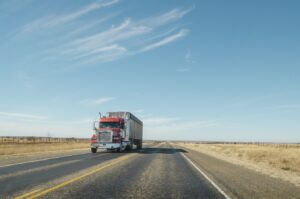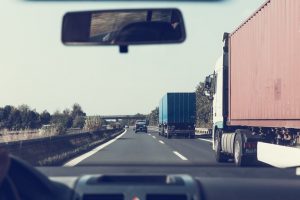Trucks and Other Large Vehicles
 When out on the road with large trucks, you have a number of challenges. You have already learned about the drafts or gusts that passing trucks create, especially at higher speeds.
When out on the road with large trucks, you have a number of challenges. You have already learned about the drafts or gusts that passing trucks create, especially at higher speeds.
There are numerous other things for you to consider, though, when you encounter trucks, especially tractor trailers:
- Never travel along one side of a large truck for too long. Trucks have larger blind spots than do other vehicles. If you cannot see the truck driver in the truck’s side mirrors, then the truck driver cannot see you. On a highway, if you are in a travel lane adjacent to a truck, stay well behind it or pass. If the truck driver must make a quick lane change due to some problem up ahead, being directly to one side is the worst place you can be.
- Similarly, never follow too closely behind a large truck. Many have signs affixed to the back advising drivers to stay at least 100 feet back, possibly even 200.
- Trucks obstruct your view. Even when following a truck at a safe distance, you cannot see everything happening up ahead. If traffic is stopped, you are at the mercy of the truck driver as to how much time you have to react and stop your own vehicle.
- Large trucks have large side mirrors. Be extra cautious at night. Even if you practice appropriate high beam/low beam techniques, your high beams might still reflect into the driver’s face. Think about keeping low beams on even when more than 200 feet behind a large truck.
- Be sure to observe all passing rules when passing a slower truck. Make sure you are well past it before you pull back into your original lane.

- The massive weight of tractor trailer requires more time and space for it to stop. In general, large trucks need twice the time and amount of space to make a safe stop than passenger vehicles do. Keep this in mind before you decide to cut across the path of a truck, possibly forcing it to make a hard stop.
- Commercial truck drivers are not allowed to “direct traffic.” Never expect the driver of a large truck to wave you on. You make the decision when it is safe to proceed.
- Many large trucks carry stone, gravel, or other loose debris. Avoid following such trucks. Small pebbles falling from them can easily damage your windshield. Larger objects falling from them are even more dangerous.
- Avoid any truck whose load appears unstable. Expect that objects will come loose and fall from the truck. When possible, alert the driver of this.
- Many buses and trucks must come to a complete stop when they approach railroad crossings. Be prepared. Most of these vehicles have stickers affixed to their rear side informing you of this fact.
- Large trucks and buses make wide turns. Avoid driving alongside a large truck as it negotiates a turn. It will likely need to turn into your lane to make a wide enough swing for a turn.
- If you approach an intersection on a two way street, take note of any large trucks. If you see that the driver has signaled to turn down your street, stop well before the intersection if your traffic signal turns red. You will provide more room for the truck driver to make a safe and complete turn. Many times, you’ll get an appreciative wave from the driver for providing them space to turn.
What If?
You are driving down the street and see a large tractor trailer stopped at a side street to your left. You know that side street has two lanes and the truck occupies the lane closest to you. The truck sits at an intersection. Seeing that the truck is fully stopped, you proceed through the intersection. Were you in any danger? Was that a safe move?
This “what if” is based on an actual event. A woman in the far lane away from you and out of your view pulled out into the path of your vehicle without so much as slowing or stopping. Because you took the time to look underneath the trailer of the truck, you saw the wheels of her vehicle moving forward and could see she was entering your path. You slowed down enough to let her pull out in front of you. For all intents and purposes, this driver pulled blindly out into the street. Her view was completely obstructed by the tractor trailer but she went anyway. Why she did that is a question only she can answer. The fact that nobody got hurt is because you used good defensive driving skills, evaluated the situation carefully, and recognized an immediate threat. You cannot see through or around large vehicles. You can see underneath. Use this technique for passenger cars and SUVs as well. Out on the road, in parking lots, or driving near parked vehicles, watch for the wheels of other vehicles. Watch for the feet of pedestrians or small animals. Prevent a collision or worse.
